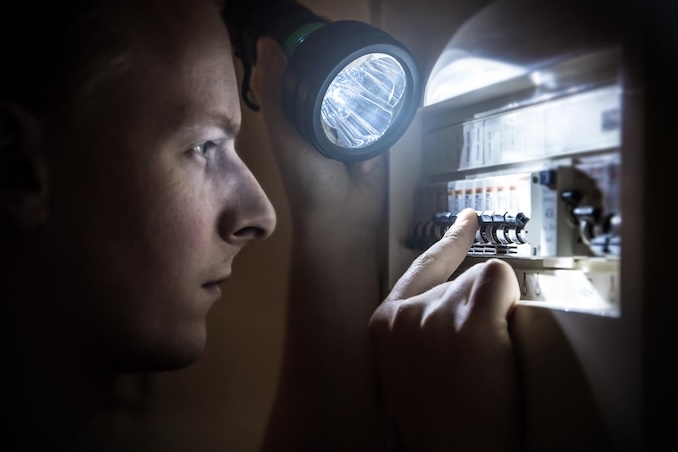If your breaker keeps tripping, it could signal an overloaded circuit, faulty wiring, or a short circuit. Frequent trips disrupt your daily routine and may indicate underlying electrical issues that require attention. While minor problems like unplugging devices can help, persistent tripping calls for professional inspection. Understanding the root cause guarantees your home remains safe and functional, preventing potential hazards and costly repairs down the line.

A tripped breaker is more than just an inconvenience; it can disrupt your daily routine and signal deeper electrical issues. Whether you’re in the middle of cooking dinner or working on your computer, a sudden loss of power can leave you frustrated and searching for answers. Understanding why this happens is crucial for maintaining a safe and functional home.
Breakers trip as a safety mechanism to prevent overheating and potential hazards. Common culprits include overloaded circuits, faulty wiring, or outdated panels. While minor adjustments like unplugging devices may resolve the issue temporarily, persistent problems often require insight from experts in custom electric services. Recognizing these signs early can save you from costly repairs and ensure your household remains secure.
Why Circuit Breakers Trip and What It Means for Your Home
Circuit breakers are a critical safety feature in any home, designed to protect your electrical system from damage. When a breaker trips, it interrupts the flow of electricity to prevent overheating, fires, or damage to appliances. Understanding why this happens is the first step toward addressing the issue effectively.
Common Causes of Breaker Trips
Breaker trips often occur due to one of the following reasons:
- Overloaded Circuits: Plugging too many devices into a single outlet or circuit can exceed its capacity.
- Short Circuits: Faulty wiring or damaged appliances may cause wires to touch, creating a dangerous surge of electricity.
- Ground Faults: When a hot wire comes into contact with a ground wire, it can trigger an immediate trip.
- Aging Electrical Panels: Older panels may lack the capacity to handle modern energy demands, leading to frequent interruptions.
These issues not only disrupt daily activities but also pose potential risks to your household’s safety. For instance, flickering lights or warm outlets are warning signs that should never be ignored. Addressing these problems promptly can prevent more significant electrical hazards.
In some cases, upgrading your electrical panel or replacing outdated wiring may be necessary. Professional assessments can help identify whether your system requires such improvements. This proactive approach supports both safety and long-term functionality.
Identifying the Root Cause of Frequent Breaker Trips
Frequent breaker trips are often a symptom of deeper electrical issues that need to be addressed promptly. By understanding the potential causes, you can take steps to resolve minor problems or recognize when professional intervention is necessary.
Signs Your Breaker May Be Overloaded
One of the most common reasons for tripped breakers is an overloaded circuit. This happens when too many appliances or devices draw power from the same circuit simultaneously. For example, running a microwave, toaster, and coffee maker on the same kitchen outlet can exceed the circuit’s capacity. Signs of overload include:
- Warm or buzzing outlets.
- Dimming lights when other appliances turn on.
- Breakers that trip repeatedly after being reset.
If you notice these signs, try redistributing high-power devices across different circuits. However, if the problem persists, it may indicate that your home’s electrical system requires an upgrade to handle modern energy demands.
Faulty Wiring: A Hidden Hazard
Damaged or outdated wiring is another frequent culprit. Homes with older wiring systems, such as aluminum or knob-and-tube wiring, are particularly vulnerable. These systems are prone to overheating, loose connections, and even electrical arcing, which can lead to breaker trips or worse – fire hazards. Warning signs include:
- Flickering or dimming lights.
- Burning odours near outlets or switches.
- Outlets that feel warm to the touch.
Addressing faulty wiring requires expertise, as improper handling can pose serious risks. In such cases, consulting a licensed electrician is essential to make sure the issue is resolved safely.
Outdated Electrical Panels: When Upgrades Are Necessary
Older homes often have electrical panels that were not designed to support today’s energy-intensive appliances. If your panel is outdated, it may lack the capacity to handle increased loads, leading to frequent breaker trips. Upgrading your electrical panel not only improves functionality but also enhances safety by meeting current code standards.
By identifying these root causes, you can take proactive steps to address the problem. Whether it’s redistributing appliances, replacing faulty wiring, or upgrading your panel, understanding the source of the issue is key to preventing future disruptions.
DIY Tips to Address Minor Electrical Issues Safely
While some electrical problems require professional expertise, there are a few minor issues you can address on your own. Taking these steps can help restore functionality and prevent unnecessary disruptions – provided you prioritize safety above all else.
Step 1: Identify Overloaded Circuits
If your breaker trips frequently, start by unplugging devices from the affected circuit. High-power appliances like space heaters, air conditioners, or washing machines often draw significant energy. Once unplugged, reset the breaker by turning it off and then back on. If the breaker holds without tripping, the issue was likely an overloaded circuit. To prevent future overloads, distribute devices across multiple outlets or circuits.
Step 2: Inspect Outlets and Switches
Warm or discoloured outlets may indicate unsafe wiring or excessive heat buildup. If you notice this, turn off the power to the outlet at your electrical panel and avoid using it until it’s inspected. Similarly, flickering lights could suggest loose connections or faulty fixtures. Tightening bulbs or replacing old switches might resolve these issues in some cases.
Step 3: Test Appliances for Faults
Sometimes, the problem isn’t with your electrical system but with a specific appliance. Plug devices into different outlets to test their functionality. If an appliance repeatedly causes the breaker to trip, it may be time to repair or replace it. For example, older appliances with worn-out cords or internal wiring issues can strain your system.
When DIY Isn’t Enough
While these tips can address minor concerns, they’re not substitutes for professional help. If you encounter persistent breaker trips, burning odors, or outdated wiring, attempting DIY fixes can worsen the problem – or even create hazardous conditions. In such cases, seeking expert guidance is the safest route forward.
Final Thoughts on Addressing Breaker Trips in Your Home
Understanding why your breaker keeps tripping is essential for maintaining a safe and functional home. From overloaded circuits to faulty wiring or outdated panels, identifying the root cause can prevent hazards and costly repairs. While minor issues can often be resolved with simple adjustments, persistent problems require professional expertise.
By staying vigilant and addressing warning signs early, you can protect your household from potential risks. Taking proactive steps today guarantees your electrical system remains reliable for years to come.
